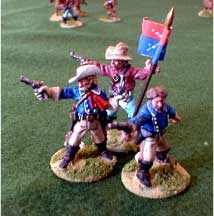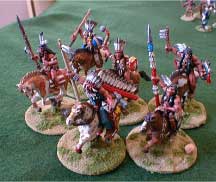 This is a revised version of a set of rules I wrote three years ago. The original version was published in The Volunteer. These rules have always given me a good battle, so the changes were minor.The main changes were to the turn sequence to eliminate simultaneous shooting, and the Indian victory points.
This is a revised version of a set of rules I wrote three years ago. The original version was published in The Volunteer. These rules have always given me a good battle, so the changes were minor.The main changes were to the turn sequence to eliminate simultaneous shooting, and the Indian victory points.
Historical Background
During the Civil War George Custer was one of the rising stars of the Union army. After that war ended he headed west to take command of the 7th cavalry. His scouts reported finding a large Indian village. Ignoring their warnings, he split his force into three columns. Custer rode into the valley of the Little Big Horn with about 200 men. None of them made it out alive. The Cheyenne and Sioux, outnumbering the troopers by at least 15 -1, fulfilled Sitting Bull's prediction and wiped them out. The death of Custer, his two brothers and nephew, and 200+ troopers in a single engagement shocked the nation. The Plains Indians war would continue. The final chapter was written in 1890 at Wounded Knee.
After Action Reports
This battle was played with two different groups of middle school students.
Battle 1
The cavalry troopers quickly realized they were surrounded by angry Indian warriors. Capt. Yates led C company in an ill advised counterattack. His command was quickly overwhelmed and annihilated by Chief Gall and his Unkpapa Sioux. Gall continued his rampage by riding alone into a cluster of terrified troopers. The mighty warrior succeeded in counting coup on them and capturing their guidon before he was joined by the rest of his war band. The other cavalry companies were doing their best to avoid a deadly close encounter with the other Indian war bands, but the situation was hopeless. The troopers were worn down by bullets and arrows, and stalked by Indian warriors who used the hills as cover to get close to the troopers. Custer and his entourage managed to survive as they attempted a fighting retreat, but the other companies were destroyed. Finally Custer and his men found their escape blocked. Sioux and Cheyenne warriors charged in from all sides, and the battle was over.
Battle 2
Companies C and L linked up at the start of the battle and formed skirmish lines, back to back, to keep the Indians at bay. It worked for a while but eventually a band of Cheyenne warriors charged into the troopers. A desperate melee was fought and the Indians were driven back. Elsewhere the cavalry retreated slowly towards the center of the battle field, using their firepower to prevent the Indians from closing in to land a knock out blow. This tactic was effective, but the Indians used their rifles and bows to return fire. The troopers could not replace their casualties, but a steady supply of new Indians arrived to keep up the pressure. Eventually the defense faltered, and the Indian charges began to hit the troopers in waves. After savage hand to hand fighting Custer and his surviving troopers were defeated.
The Forces
Adjust the number of Indian and Cavalry groups to suit the number of players in your game. Just make sure there are plenty of Indians. For this battle I used some 25mm metal figures that I had already painted. 1/72 scale plastic figures are available from Imex. Here are some paper soldiers you can print and use Cavalry colored, Indians colored, Cavalry black & white, Indians black & white. The black & white soldiers can be reproduced on a copying machine (print opposing armies on different colored paper) or given to the kids to color.
 Indians
Indians
We played the game with six Indian bands representing the Northern and Southern Cheyenne, plus the Ogallala, Hunkpapa, Minneconjous, Brule, and Sans Arc Sioux. Each band had 10 - 12 warriors on foot and one mounted Chief. The warriors had a mix of bows, rifles, and melee weapons. A marker was placed along the board edge for each band to mark their entry point. The bands should be spread all around the board so that Indians are entering the board from all directions.
The Cavalry
Custer and a trooper holding his guidon were placed at the center of the board. Five Groups of 10-12 troopers were placed in random directions about 12" from Custer. These represent the surviving members of companies C, E, F, L and I. Each has a guidon and an officer.
The Board
We played the battle on a 7.5' x 5' table. The battlefield should include plenty of low hills. You can use felt to represent these if necessary. Hills block line of sight for shooting, but don't effect movement.
Objective
Since this is a one-sided battle the goal isn't simply to win. Instead, each player is competing against his teammates. The Indians are competing to see which war band can win the most honors; the cavalry are competing to see who can last the longest. Indian bands can earn honor points for defeating an enemy in melee, capturing a guidon, or for a chief counting coup. (see table). The band that earns the most points is the Indian winner. The Cavalry company that keeps its guidon the longest is the Cavalry winner.
Indian Honor Points
Defeat enemy figure in melee 1
Chief counts coup successfully 2
Capture guidon 1
Capture Custer's guidon 2
Useful Resources
Son of the Morning Star by Evan S. Connell
Killing Custer by James Welch
"Painting the Plains" by Mark Copplestone (http://www.wargamesfoundry.com/library/)
"Custer's Luck" by Mark Hannam, The Gauntlet #20
"Sioux Wars" by Pete Panzeri, After Action Review #2-8
The American Plains Indians, Osprey Men-at-Arms Series # 163 by Jason Hook & Richard Hook
Counting Coup on Custer Little Big Horn Battle
- Historical Background and Set Up
Fast Play Rules for Students
Paper Soldiers and LBH (very slow: 263K)
Back to Table of Contents -- Junior General Report # 4
Back to Junior General Report List of Issues
Back to MagWeb.com Magazine List
© Copyright 2004 by Matt Fritz.
This article appears in MagWeb.com (Magazine Web) on the Internet World Wide Web. Other articles covering military history and related topics are available at http://www.magweb.com